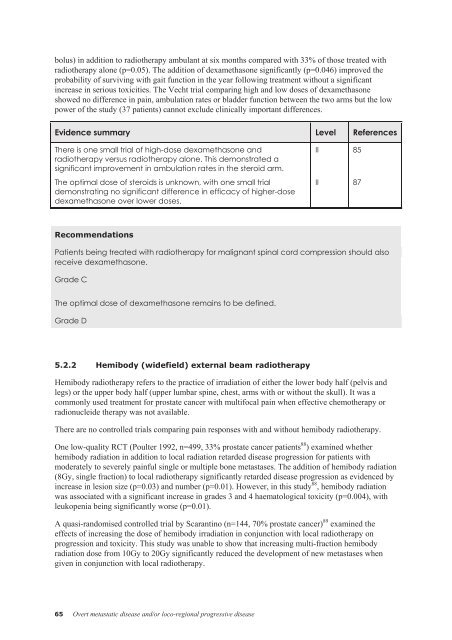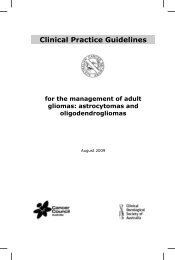Clinical Practice Guidelines for the management of locally advanced ...
Clinical Practice Guidelines for the management of locally advanced ...
Clinical Practice Guidelines for the management of locally advanced ...
You also want an ePaper? Increase the reach of your titles
YUMPU automatically turns print PDFs into web optimized ePapers that Google loves.
olus) in addition to radio<strong>the</strong>rapy ambulant at six months compared with 33% <strong>of</strong> those treated with<br />
radio<strong>the</strong>rapy alone (p=0.05). The addition <strong>of</strong> dexamethasone significantly (p=0.046) improved <strong>the</strong><br />
probability <strong>of</strong> surviving with gait function in <strong>the</strong> year following treatment without a significant<br />
increase in serious toxicities. The Vecht trial comparing high and low doses <strong>of</strong> dexamethasone<br />
showed no difference in pain, ambulation rates or bladder function between <strong>the</strong> two arms but <strong>the</strong> low<br />
power <strong>of</strong> <strong>the</strong> study (37 patients) cannot exclude clinically important differences.<br />
Evidence summary Level References<br />
There is one small trial <strong>of</strong> high-dose dexamethasone and<br />
radio<strong>the</strong>rapy versus radio<strong>the</strong>rapy alone. This demonstrated a<br />
significant improvement in ambulation rates in <strong>the</strong> steroid arm.<br />
The optimal dose <strong>of</strong> steroids is unknown, with one small trial<br />
demonstrating no significant difference in efficacy <strong>of</strong> higher-dose<br />
dexamethasone over lower doses.<br />
Recommendations<br />
II 85<br />
II 87<br />
Patients being treated with radio<strong>the</strong>rapy <strong>for</strong> malignant spinal cord compression should also<br />
receive dexamethasone.<br />
Grade C<br />
The optimal dose <strong>of</strong> dexamethasone remains to be defined.<br />
Grade D<br />
5.2.2 Hemibody (widefield) external beam radio<strong>the</strong>rapy<br />
Hemibody radio<strong>the</strong>rapy refers to <strong>the</strong> practice <strong>of</strong> irradiation <strong>of</strong> ei<strong>the</strong>r <strong>the</strong> lower body half (pelvis and<br />
legs) or <strong>the</strong> upper body half (upper lumbar spine, chest, arms with or without <strong>the</strong> skull). It was a<br />
commonly used treatment <strong>for</strong> prostate cancer with multifocal pain when effective chemo<strong>the</strong>rapy or<br />
radionucleide <strong>the</strong>rapy was not available.<br />
There are no controlled trials comparing pain responses with and without hemibody radio<strong>the</strong>rapy.<br />
One low-quality RCT (Poulter 1992, n=499, 33% prostate cancer patients 88 ) examined whe<strong>the</strong>r<br />
hemibody radiation in addition to local radiation retarded disease progression <strong>for</strong> patients with<br />
moderately to severely painful single or multiple bone metastases. The addition <strong>of</strong> hemibody radiation<br />
(8Gy, single fraction) to local radio<strong>the</strong>rapy significantly retarded disease progression as evidenced by<br />
increase in lesion size (p=0.03) and number (p=0.01). However, in this study 88 , hemibody radiation<br />
was associated with a significant increase in grades 3 and 4 haematological toxicity (p=0.004), with<br />
leukopenia being significantly worse (p=0.01).<br />
A quasi-randomised controlled trial by Scarantino (n=144, 70% prostate cancer) 89 examined <strong>the</strong><br />
effects <strong>of</strong> increasing <strong>the</strong> dose <strong>of</strong> hemibody irradiation in conjunction with local radio<strong>the</strong>rapy on<br />
progression and toxicity. This study was unable to show that increasing multi-fraction hemibody<br />
radiation dose from 10Gy to 20Gy significantly reduced <strong>the</strong> development <strong>of</strong> new metastases when<br />
given in conjunction with local radio<strong>the</strong>rapy.<br />
65<br />
Overt metastatic disease and/or loco-regional progressive disease



